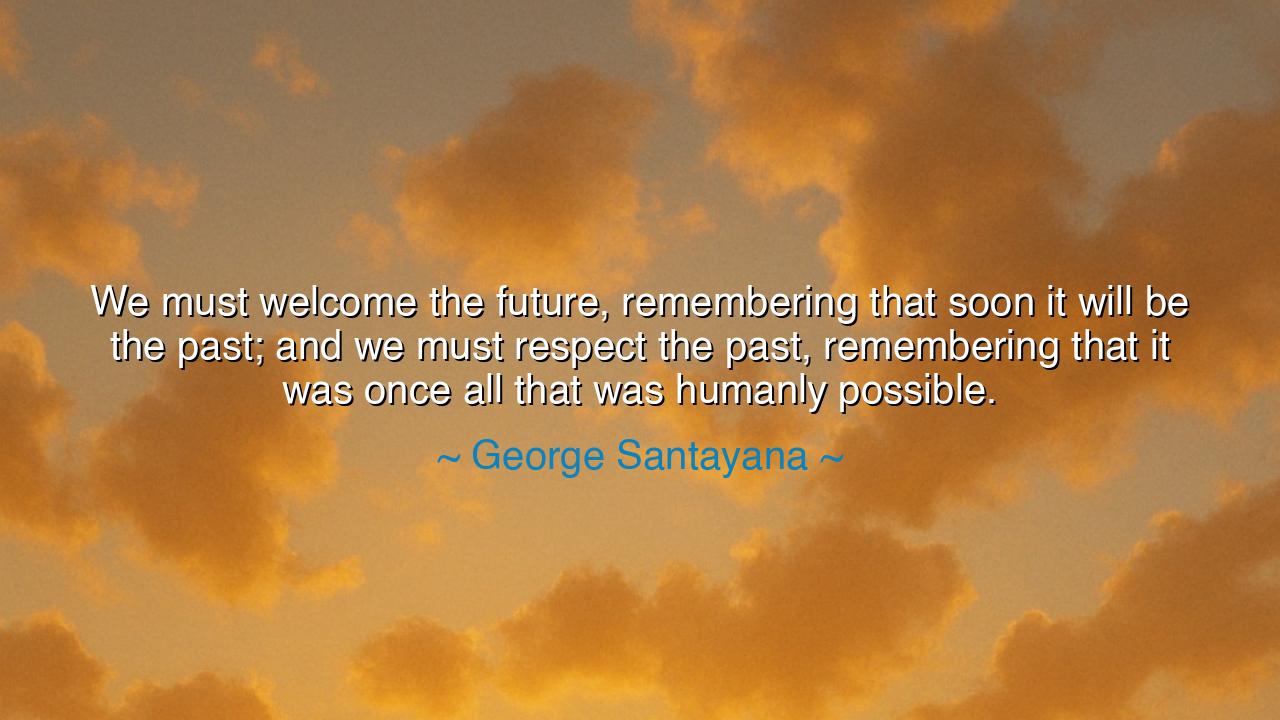
We must welcome the future, remembering that soon it will be the
We must welcome the future, remembering that soon it will be the past; and we must respect the past, remembering that it was once all that was humanly possible.






Hear now, O children of time, for the words of George Santayana offer profound insight into the relationship between the past, the present, and the future. He said—"We must welcome the future, remembering that soon it will be the past; and we must respect the past, remembering that it was once all that was humanly possible." In these words, Santayana reveals the interconnectedness of time and the wisdom we can gain from both looking forward and looking back. The future may be a place of hope, of dreams yet to unfold, but it too will soon be swallowed by the passage of time, becoming a memory, just as the past was once the horizon that guided our steps. And so, Santayana teaches us that both past and future have their place, and it is through the understanding of both that we navigate the present with wisdom and grace.
What does it mean to "welcome the future"? The future, O children, is a land of possibility, an unknown expanse that beckons with the promise of growth, change, and advancement. To welcome the future is to greet it with open arms, with hope and excitement for what lies ahead, knowing that it holds the potential for all that we have yet to become. Yet, Santayana’s wisdom calls us to remember that the future will not remain forever in the realm of the unknown—it will soon become the past, a moment in time that will be shaped by the choices we make today. Thus, we are reminded that the future is fleeting, and it is only through embracing it in the present that we shape the legacy we leave behind.
**Consider the story of the great inventor Thomas Edison, whose inventions changed the course of history. Edison looked to the future, his mind filled with visions of electric light, of machines that would improve the lives of millions. His belief in the future led him to tirelessly work, to experiment, to fail, and to create. Yet, once he achieved his goals, his inventions became the past, and the future of energy and innovation moved on to new horizons. Edison’s work was not only about embracing the future, but about shaping it in ways that would transform the world. In his example, we see the power of welcoming the future with dedication, knowing that each step forward creates a new past for future generations to build upon.
But Santayana’s words are not only a call to look ahead; they also urge us to respect the past. The past, O children, is not to be forgotten or dismissed as irrelevant—it is the foundation upon which we build the present and the future. Just as Edison’s work was made possible by the innovations of those who came before him, so too must we honor the achievements, struggles, and lessons of those who paved the way for us. History is a living teacher, reminding us that the past was once the limit of human possibility, that what we now take for granted was once a dream or a struggle.
Let us, for example, look to the architects of ancient Rome, whose engineering marvels—such as the aqueducts and the Colosseum—still stand as symbols of human achievement. The builders of Rome did not have the technology we now take for granted, yet they created structures that withstood the ravages of time. The past, for them, was the edge of human possibility, and they embraced it with all the tools and knowledge they had. Today, we stand on the shoulders of such giants, their work still influencing the engineering marvels of the modern world. We must respect the past, not as a relic to be ignored, but as a testament to human ingenuity, determination, and vision.
In the same vein, the wise philosopher Socrates understood the importance of learning from those who came before him. Though he challenged the beliefs of his time, Socrates did not dismiss the past—he learned from it, questioned it, and built upon it. In his own words, he said, “The unexamined life is not worth living.” This reflects Santayana’s teaching that we must respect the past, not merely as history, but as a source of wisdom, a guide to how we live today.
The lesson, O children, is one of balance. Embrace the future, but do not chase it at the expense of the wisdom and legacy that the past provides. Respect the past, but do not be shackled by it. The future and the past are intertwined, each shaping the other. We cannot live in the past, but we must carry its lessons forward, learning from its triumphs and its mistakes. We must welcome the future with open hearts, knowing that it is the result of the choices we make today, and that those choices will soon become part of the past. In embracing the future, we shape the past we will leave behind for those who come after us.
Thus, let us go forward, O children, with both reverence for the past and hope for the future. Let us build a world that honors the lessons of history while striving to create a better tomorrow. In doing so, we honor not just the past and the future, but the very present moment—the only time we truly possess. Live with purpose, for the future begins with the choices we make today, and the past will one day carry the imprint of all that we achieve. May our legacy be one of wisdom, compassion, and vision, forever shaped by the past and the future intertwined.






AAdministratorAdministrator
Welcome, honored guests. Please leave a comment, we will respond soon